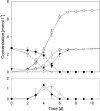Glycine betaine as a direct substrate for methanogens (Methanococcoides spp.)
- PMID: 24162571
- PMCID: PMC3911008
- DOI: 10.1128/AEM.03076-13
Glycine betaine as a direct substrate for methanogens (Methanococcoides spp.)
Abstract
Nine marine methanogenic Methanococcoides strains, including the type strains of Methanococcoides methylutens, M. burtonii, and M. alaskense, were tested for the utilization of N-methylated glycines. Three strains (NM1, PM2, and MKM1) used glycine betaine (N,N,N-trimethylglycine) as a substrate for methanogenesis, partially demethylating it to N,N-dimethylglycine, whereas none of the strains used N,N-dimethylglycine or sarcosine (N-methylglycine). Growth rates and growth yields per mole of substrate with glycine betaine (3.96 g [dry weight] per mol) were similar to those with trimethylamine (4.11 g [dry weight] per mol). However, as glycine betaine is only partially demethylated, the yield per methyl group was significantly higher than with trimethylamine. If glycine betaine and trimethylamine are provided together, trimethylamine is demethylated to dimethyl- and methylamine with limited glycine betaine utilization. After trimethylamine is depleted, dimethylamine and glycine betaine are consumed rapidly, before methylamine. Glycine betaine extends the range of substrates that can be directly utilized by some methanogens, allowing them to gain energy from the substrate without the need for syntrophic partners.
Figures


 , trimethylamine; ▼, ammonium; ◆ dimethylamine; ◊, methylamine.
, trimethylamine; ▼, ammonium; ◆ dimethylamine; ◊, methylamine.Similar articles
-
Methanococcoides vulcani sp. nov., a marine methylotrophic methanogen that uses betaine, choline and N,N-dimethylethanolamine for methanogenesis, isolated from a mud volcano, and emended description of the genus Methanococcoides.Int J Syst Evol Microbiol. 2014 Jun;64(Pt 6):1978-1983. doi: 10.1099/ijs.0.058289-0. Epub 2014 Mar 10. Int J Syst Evol Microbiol. 2014. PMID: 24614846
-
Choline and N,N-dimethylethanolamine as direct substrates for methanogens.Appl Environ Microbiol. 2012 Dec;78(23):8298-303. doi: 10.1128/AEM.01941-12. Epub 2012 Sep 21. Appl Environ Microbiol. 2012. PMID: 23001649 Free PMC article.
-
Utilization of trimethylamine and other N-methyl compounds for growth and methane formation by Methanosarcina barkeri.Proc Natl Acad Sci U S A. 1979 Jan;76(1):494-8. doi: 10.1073/pnas.76.1.494. Proc Natl Acad Sci U S A. 1979. PMID: 284366 Free PMC article.
-
Formation and breakdown of glycine betaine and trimethylamine in hypersaline environments.Antonie Van Leeuwenhoek. 1990 Nov;58(4):291-8. doi: 10.1007/BF00399342. Antonie Van Leeuwenhoek. 1990. PMID: 2082817 Review.
-
Several ways one goal-methanogenesis from unconventional substrates.Appl Microbiol Biotechnol. 2020 Aug;104(16):6839-6854. doi: 10.1007/s00253-020-10724-7. Epub 2020 Jun 15. Appl Microbiol Biotechnol. 2020. PMID: 32542472 Free PMC article. Review.
Cited by
-
Ecology of Methanonatronarchaeia.Environ Microbiol. 2022 Nov;24(11):5217-5229. doi: 10.1111/1462-2920.16108. Epub 2022 Jul 18. Environ Microbiol. 2022. PMID: 35726892 Free PMC article.
-
Microbial Sulfate Reduction Potential in Coal-Bearing Sediments Down to ~2.5 km below the Seafloor off Shimokita Peninsula, Japan.Front Microbiol. 2016 Oct 5;7:1576. doi: 10.3389/fmicb.2016.01576. eCollection 2016. Front Microbiol. 2016. PMID: 27761134 Free PMC article.
-
Evidence of active methanogen communities in shallow sediments of the sonora margin cold seeps.Appl Environ Microbiol. 2015 May 15;81(10):3451-9. doi: 10.1128/AEM.00147-15. Epub 2015 Mar 13. Appl Environ Microbiol. 2015. PMID: 25769831 Free PMC article.
-
Genome Sequences of Two Choline-Utilizing Methanogenic Archaea, Methanococcoides spp., Isolated from Marine Sediments.Microbiol Resour Announc. 2019 May 2;8(18):e00342-19. doi: 10.1128/MRA.00342-19. Microbiol Resour Announc. 2019. PMID: 31048384 Free PMC article.
-
Diverse methylotrophic methanogenic archaea cause high methane emissions from seagrass meadows.Proc Natl Acad Sci U S A. 2022 Mar 1;119(9):e2106628119. doi: 10.1073/pnas.2106628119. Proc Natl Acad Sci U S A. 2022. PMID: 35165204 Free PMC article.
References
Publication types
MeSH terms
Substances
LinkOut - more resources
Full Text Sources
Other Literature Sources
Miscellaneous

